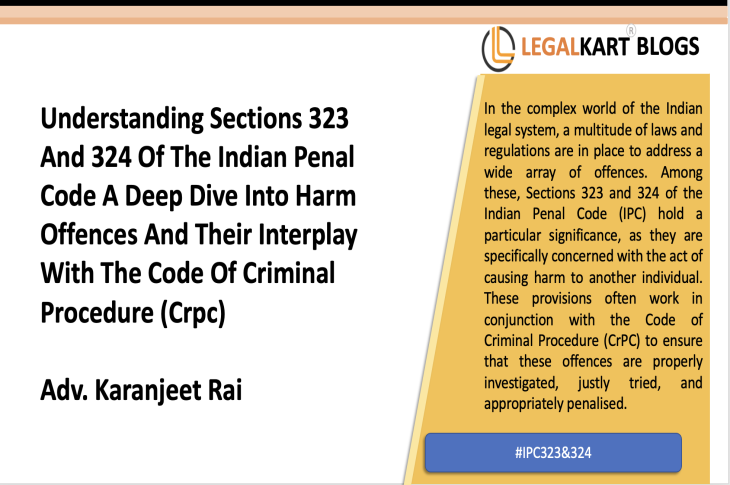Indian Penal Code Sections 323 & 324 Explained - Legalkart
Unpacking Sections 323 and 324 of the Indian Penal Code & navigating harm offences in India read with the Code of Criminal Procedure Code (CrPC)
In the complex world of the Indian legal system, a multitude of laws and regulations are in place to address a wide array of offences. Among these, Sections 323 and 324 of the Indian Penal Code (IPC) hold a particular significance, as they are specifically concerned with the act of causing harm to another individual. These provisions often work in conjunction with the Code of Criminal Procedure (CrPC) to ensure that these offences are properly investigated, justly tried, and appropriately penalised.
Section 323 of the IPC: Intentional Harm
Section 323 of the IPC is all about intentionally causing harm to another person. Simply put, if someone hurts another person on purpose, without a valid excuse, they can face legal consequences. The punishment for such an offence can include imprisonment for up to one year, a fine, or both. It's important to know that this offence is considered "non-cognizable," which means the police can't arrest someone for it without a special permission document known as a "warrant." Any magistrate can handle cases under this section. Think of it this way: if someone intentionally pushes, hits, or harms another person without a good reason, they can get in trouble under this rule. It's not as serious as when weapons or very dangerous things are involved, but it's still a legal matter that needs to be addressed.
Section 324 of the IPC: Harm with Dangerous Weapons
On the other hand, Section 324 of the IPC deals with cases where harm is caused using dangerous weapons or methods. This rule specifies that if someone voluntarily hurts another person using a deadly weapon or a dangerous method, with the intention of causing severe harm or knowing that their actions might result in severe harm, they can face severe legal consequences. The punishment for this offence can include imprisonment for up to three years, a fine, or both. Notably, this is considered a "non-bailable" offence, which means that the accused can't automatically get bail. Like Section 323, cases under Section 324 can be handled by any magistrate. Imagine this rule as addressing situations where someone uses a weapon like a knife or a dangerous method to harm another person. It's more severe because it involves serious harm or the potential for serious harm.
CrPC and Section 323/324: Legal Procedures
Now, when it comes to investigating and putting someone on trial for breaking these rules, we turn to the Code of Criminal Procedure (CrPC). The CrPC is like a comprehensive guidebook for the police and the courts on how to do things right. For example, the CrPC explains the procedures that law enforcement agencies must follow when investigating cases under Sections 323 and 324. This includes gathering evidence, talking to witnesses, and ensuring that the rights of the accused person are respected. The CrPC also defines the conditions under which a person accused of these offences may be granted bail. Importantly, it makes it clear that bail is not an automatic right for those charged with non-bailable offences. When it comes to a trial, the CrPC serves as the rulebook. It ensures that the trial is fair for both sides, the person accused and the person making the accusations. It helps the judge make sure everything is done properly and without any bias.
Conclusion: Upholding Justice
In summary, Section 323 and Section 324 of the IPC are essential parts of India's legal framework, dealing with offences related to causing harm to another person. It's crucial for individuals to understand these sections to be aware of their rights and what they can do if they've been harmed.
Working hand in hand with these sections, the Code of Criminal Procedure (CrPC) serves as a guiding force, ensuring a comprehensive, just, and fair legal process. By upholding the principles of justice and fairness, Sections 323 and 324, along with the CrPC, significantly contribute to the establishment of a just legal system in India. This system prioritises the protection of rights, proper investigation of offences, and the fair trial of individuals accused of causing harm to others. These principles are fundamental to the Indian legal system, aiming to provide justice for all.
Frequently asked questions
What constitutes 'hurt' under Section 323 of the IPC?
What constitutes 'hurt' under Section 323 of the IPC?
Under Section 323, 'hurt' encompasses any bodily pain, disease, or infirmity caused to a person through intentional actions.
What is the punishment for voluntarily causing hurt under Section 323?
What is the punishment for voluntarily causing hurt under Section 323?
The punishment for voluntarily causing hurt under Section 323 may extend to imprisonment for up to one year, or a fine, or both.
What distinguishes Section 324 from Section 323 of the IPC?
What distinguishes Section 324 from Section 323 of the IPC?
Section 324 extends the scope by including cases where hurt is caused using dangerous weapons or means, whereas Section 323 covers intentional hurt without specific mention of weapons.
What are examples of dangerous weapons or means under Section 324?
What are examples of dangerous weapons or means under Section 324?
Dangerous weapons or means include instruments for shooting, stabbing, cutting, or any object used as a weapon of offense capable of inflicting severe harm.
Is there a difference in punishment between Sections 323 and 324?
Is there a difference in punishment between Sections 323 and 324?
Yes, the punishment under Section 324 is more severe, with imprisonment extending up to three years, or a fine, or both, compared to Section 323.
Are offenses under Sections 323 and 324 cognizable or non-cognizable?
Are offenses under Sections 323 and 324 cognizable or non-cognizable?
These offenses are generally non-cognizable, meaning the police cannot arrest the accused without a warrant, except in specified circumstances.
What is the role of the Code of Criminal Procedure (CrPC) in cases under Sections 323 and 324?
What is the role of the Code of Criminal Procedure (CrPC) in cases under Sections 323 and 324?
The CrPC provides procedural guidelines for reporting offenses, arrest, investigation, trial, and conviction, ensuring fair and efficient legal proceedings.
Can the accused secure bail in cases under Sections 323 and 324?
Can the accused secure bail in cases under Sections 323 and 324?
Yes, in most cases, the accused is entitled to bail as a matter of right, given the offenses are generally non-cognizable and bailable.
What steps are involved in the trial of cases under Sections 323 and 324?
What steps are involved in the trial of cases under Sections 323 and 324?
The trial involves presenting evidence by the prosecution, the right of the accused to defend themselves, and the pronouncement of the appropriate sentence by the court upon conviction.
How can individuals ensure justice and accountability in cases involving harmful offenses?
How can individuals ensure justice and accountability in cases involving harmful offenses?
Understanding the provisions of the IPC, particularly Sections 323 and 324, and familiarizing oneself with the procedural aspects outlined in the CrPC, empowers individuals to navigate the legal landscape effectively, promoting justice and accountability.
Trending
Frequently asked questions
What constitutes 'hurt' under Section 323 of the IPC?
What constitutes 'hurt' under Section 323 of the IPC?
Under Section 323, 'hurt' encompasses any bodily pain, disease, or infirmity caused to a person through intentional actions.
What is the punishment for voluntarily causing hurt under Section 323?
What is the punishment for voluntarily causing hurt under Section 323?
The punishment for voluntarily causing hurt under Section 323 may extend to imprisonment for up to one year, or a fine, or both.
What distinguishes Section 324 from Section 323 of the IPC?
What distinguishes Section 324 from Section 323 of the IPC?
Section 324 extends the scope by including cases where hurt is caused using dangerous weapons or means, whereas Section 323 covers intentional hurt without specific mention of weapons.
What are examples of dangerous weapons or means under Section 324?
What are examples of dangerous weapons or means under Section 324?
Dangerous weapons or means include instruments for shooting, stabbing, cutting, or any object used as a weapon of offense capable of inflicting severe harm.
Is there a difference in punishment between Sections 323 and 324?
Is there a difference in punishment between Sections 323 and 324?
Yes, the punishment under Section 324 is more severe, with imprisonment extending up to three years, or a fine, or both, compared to Section 323.
Are offenses under Sections 323 and 324 cognizable or non-cognizable?
Are offenses under Sections 323 and 324 cognizable or non-cognizable?
These offenses are generally non-cognizable, meaning the police cannot arrest the accused without a warrant, except in specified circumstances.
What is the role of the Code of Criminal Procedure (CrPC) in cases under Sections 323 and 324?
What is the role of the Code of Criminal Procedure (CrPC) in cases under Sections 323 and 324?
The CrPC provides procedural guidelines for reporting offenses, arrest, investigation, trial, and conviction, ensuring fair and efficient legal proceedings.
Can the accused secure bail in cases under Sections 323 and 324?
Can the accused secure bail in cases under Sections 323 and 324?
Yes, in most cases, the accused is entitled to bail as a matter of right, given the offenses are generally non-cognizable and bailable.
What steps are involved in the trial of cases under Sections 323 and 324?
What steps are involved in the trial of cases under Sections 323 and 324?
The trial involves presenting evidence by the prosecution, the right of the accused to defend themselves, and the pronouncement of the appropriate sentence by the court upon conviction.
How can individuals ensure justice and accountability in cases involving harmful offenses?
How can individuals ensure justice and accountability in cases involving harmful offenses?
Understanding the provisions of the IPC, particularly Sections 323 and 324, and familiarizing oneself with the procedural aspects outlined in the CrPC, empowers individuals to navigate the legal landscape effectively, promoting justice and accountability.



Ask a Lawyer